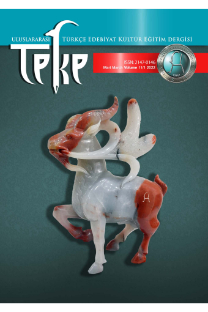“WHEN PERSIA MEETS THE CAUCUSES THROUGH POETRY”: ASHRAF OF GILAN’S ALLUSION TO MIRZA ALAKBAR SABIR DURING THE IRANIAN CONSTITUTIONAL ERA
Azerbaijani Turkish literature, Persian literature, Mirza Alakbar Sabir, Ashrafedin Hosseini Gilani, Molla Nasraddin magazine
WHEN PERSIA MEETS THE CAUCUSES THROUGH POETRY”: ASHRAF OF GILAN’S ALLUSION TO MIRZA ALAKBAR SABIR DURING THE IRANIAN CONSTITUTIONAL ERA
Azerbaijani Turkish literature, Persian literature, Mirza Alakbar Sabir, Ashrafedin Hosseini Gilani, Molla Nasraddin magazine,
___
- Arianpour, Y. (1372/1993-94). Az Sabā tā Nimā (From Saba to Nima) (Vol. 2). (5th ed.). Zavvar. [In Persian]
- Ashraf, S. G. (1371/1992-93). Koliyāt-e Jāvdāne-ye Nasim-e Shomāl (Collection of everlasting Nasim-e Shomal). Asatir. [In Persian]
- Bahar, M (1336/1957-58). Divān-e Ashār-e Bahār (A poetry collection of Bahar). Amir Kabir. [In Persian]
- Browne, G., E. (1914). The press and poetry of modern Persia. Cambridge University Press.
- Faghih, E. (2017). Echoes of Iranian Azerbaijani-Turkish Poetry. (2nd ed.). Bridges Publishing.
- Haughton, H. (2011) Allusion: the case of Shakespeare. In T. S. Eliot in context. Edited by Jason Harding. Cambridge University Press. pp. 157-168.
- Hirsch, E. (2022, May 31). Political Poetry: Explore the glossary of poetic terms. https://poets.org/glossary/political-poetry.
- Kasravi, A. (1370/1991-92). Tārikh-e Mashrute-ye Iran (History of the Iranian constitutional revolution). (6th ed.). Amir Kabir. [In Persian]
- Sabir, M. A. (1914). Hophopname. Baku. [In Azerbaijani Turkish]
- Seif, A., & Bakhshi, H. (2012). A Study of the Influences of Seyyed Ashraf Gilani on the Poetry of Mirza Ali Akbar Saber. Quarterly Journal of Persian Poetry and Poetry (Bahar Adab), 5(4): 203-215. [In Persian]
- Shahriar, M. (1387/2008). Divan-e Shariar (A poetry collection of Shahriar). Negah. [In Persian]
- Shahriar, M. (1377/1998). Divan-e Turkiye Shariar be Enzemam-e Heydar Babaya Salam (The Turkish poetry collection of Shahriar including Heydar Babaya Salam). Negah. [In Azerbaijani Turkish]
- Shams Langaroodi, M. T. J. G. (1377/1998). Tarikhe Tahlili-ye Sher-e Now (An analytic history of Persian modern poetry). (Vol 1). (2nd ed.). Nashr-e Markaz publishing Co. [In Persian]
- Tearle, O. (2022, May 31). The Meaning and Origin of ‘Immature Poets Imitate; Mature Poets Steal’. Interesting literature. https://interestingliterature.com/.
- ISSN: 2147-0146
- Yayın Aralığı: 4
- Başlangıç: 2012
- Yayıncı: Cengiz Alyılmaz
ERKEN ÇOCUKLUK DÖNEMİNDE X VE Z KUŞAKLARINDA OYNANAN GELENEKSEL ÇOCUK OYUNLARI: KIRŞEHİR İLİ ÖRNEĞİ
TÜRKİYE TÜRKÇESİNDE TESPİH KULLANIMINA DAİR İFADELER: KARS İLİ AĞIZLARI ÖRNEĞİ
PERİ MASALLARINA ELEŞTİREL BİR BAKIŞ
MÜASİR TÜRK TOPLUMLARINDA DİL SİYASƏTİ (GÜRCÜSTANDA TÜRK DİLİ İLƏ BAĞLI APARILAN DİL SİYASƏTİ)
YAZARLARIN GÖZÜYLE BURSA’YA SEYAHAT (1889-1925)
Zuhal EROĞLU KOŞAN, Alev SINAR UĞURLU
Aysun AKGÜL, Çiğdem ALDAN KARADEMİR
PİPPİ UZUNÇORAP SERİSİNİN DEMOKRATİK KÜLTÜR BİLİNCİ EDİNİMİNE ETKİSİ
KUZEY MAKEDONYA İŞTİP AĞZINDA KULLANILAN TÜRKİZMALAR
Raşit KOÇ, Süleyman BAKİ, Dragan ÇİTKUŞEV
TÜRKMEN TÜRKÇESİNDE YÖNELME HÂLİ EKİNİN “+yA” ŞEKLİ
MOBY DICK VE TİAMAT ADLI ROMANLARDA MODERNİTENİN ZİHİNSEL GİRDABI: DİN VE DİNDIŞILIK ÇATIŞMASI
